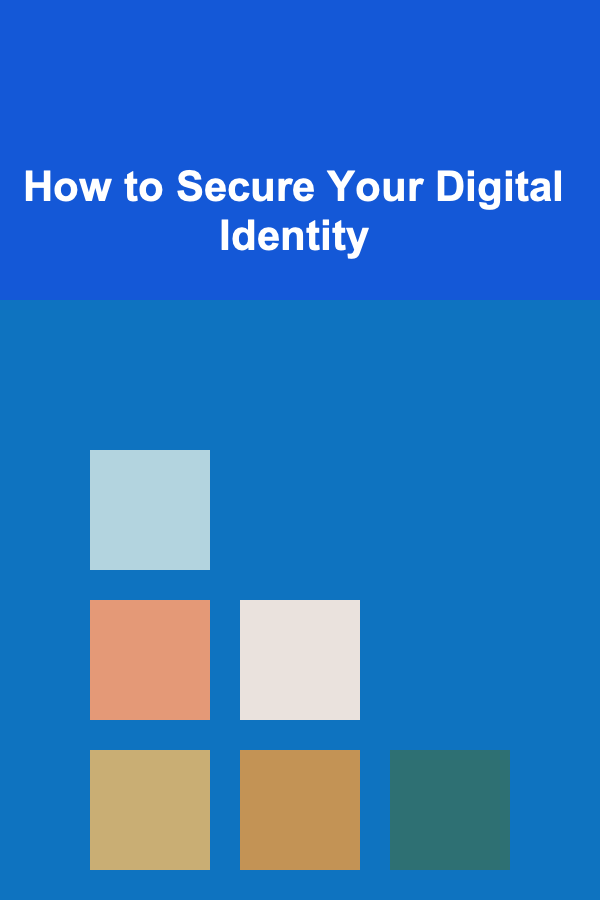
How to Secure Your Digital Identity
ebook include PDF & Audio bundle (Micro Guide)
$12.99$6.99
Limited Time Offer! Order within the next:

In today's fast-paced and interconnected world, securing your digital identity has become more important than ever before. With almost every aspect of our lives now taking place online---from banking and shopping to social interactions and professional networking---our digital identity represents a crucial part of who we are. It's no longer just about usernames and passwords; digital identity encompasses everything that makes us identifiable in the online world.
In this article, we will delve into what digital identity is, why it's so important, the risks associated with it, and most importantly, how you can secure your digital identity to safeguard your personal and financial information from cybercriminals.
What is Digital Identity?
A digital identity refers to the online representation of an individual, which is made up of a variety of digital attributes, such as usernames, passwords, email addresses, social media profiles, online behaviors, and financial information. It also includes personal data such as photos, videos, posts, and any other data you've shared or that others have shared about you online.
While digital identity provides convenience and connectivity, it also opens the door to numerous risks, such as identity theft, fraud, and privacy violations. Understanding these risks and the importance of digital identity is key to taking the necessary steps to protect it.
Why Is Digital Identity Important?
1. Access to Personal Information
Your digital identity is a gateway to your sensitive personal information. This includes not only financial data (such as bank accounts and credit card numbers) but also personal data like your address, phone number, and social security number. If this data falls into the wrong hands, the consequences can be severe---ranging from financial losses to long-lasting reputational damage.
2. Financial Transactions and Online Purchases
Every time you make a financial transaction or purchase something online, your digital identity is used. E-commerce websites, banking platforms, and other online services rely on the authentication of your identity to allow transactions. Ensuring your digital identity is secure means ensuring that these transactions are not vulnerable to interception or fraud.
3. Social Interactions and Reputation Management
In the digital age, your online behavior plays a key role in shaping your personal and professional reputation. From LinkedIn profiles to Facebook posts, what you do online contributes to the public's perception of you. A compromised digital identity could lead to misrepresentation, privacy violations, and even cyberbullying.
4. Access to Services and Benefits
Many services today are tied to your digital identity. This includes access to work-related platforms, government services, healthcare portals, and educational institutions. The breach of your digital identity could limit or block your access to these essential services, leading to significant disruptions in your life.
Risks to Digital Identity
Before diving into the strategies to protect your digital identity, it's essential to understand the risks involved. Some of the most common threats to digital identity include:
1. Phishing Attacks
Phishing attacks involve tricking individuals into providing personal information, often by pretending to be trustworthy sources. Cybercriminals often use emails or fake websites that look legitimate, but their sole purpose is to steal your login credentials, credit card details, or other personal information.
2. Identity Theft
Identity theft is when someone uses your personal information---like your name, social security number, or banking details---to impersonate you. This can result in fraudulent activities like opening accounts in your name, making unauthorized purchases, or even taking out loans in your name.
3. Data Breaches
Data breaches occur when an organization's database containing sensitive information is hacked or compromised. These breaches can expose millions of people's personal data, including usernames, passwords, credit card numbers, and more. Unfortunately, such breaches are increasingly common, and once your data is exposed, it may be used maliciously.
4. Malware and Ransomware
Malware refers to malicious software that can compromise your digital devices and steal personal data. Ransomware is a particularly dangerous type of malware that encrypts your files and demands a ransom to decrypt them. Both forms of malware can wreak havoc on your digital life if you're not careful.
5. Social Engineering
Social engineering involves manipulating people into divulging confidential information by exploiting human psychology. This could involve impersonating someone you trust or exploiting your emotional state to make you reveal passwords or other sensitive details.
How to Secure Your Digital Identity
Now that we understand the risks, let's explore actionable steps you can take to secure your digital identity.
1. Use Strong, Unique Passwords
One of the most basic but essential ways to secure your digital identity is by using strong, unique passwords for each of your accounts. Weak or reused passwords are easy for cybercriminals to crack or guess. A strong password should contain a mix of uppercase and lowercase letters, numbers, and special characters. It should also be at least 12 characters long.
2. Enable Two-Factor Authentication (2FA)
Two-factor authentication (2FA) adds an extra layer of security to your accounts by requiring two forms of identification: something you know (your password) and something you have (a code sent to your phone or email). Even if a cybercriminal obtains your password, they won't be able to access your account without the second form of verification.
Most major online services, including Google, Facebook, and your bank, offer 2FA. Always enable this feature whenever possible.
3. Use Password Managers
Given the sheer number of passwords we need to remember for various accounts, using a password manager is highly recommended. Password managers can generate strong, unique passwords for each account and store them securely. This way, you don't have to worry about remembering complex passwords or reusing them across multiple sites.
4. Monitor Your Accounts and Financial Transactions
Regularly monitor your online accounts for any suspicious activity. Check your bank statements, credit card transactions, and social media profiles to ensure that nothing looks out of the ordinary. Early detection of fraud can help mitigate the damage caused by a compromised account.
Additionally, consider setting up alerts for your bank and credit cards to be notified of any large or unusual transactions.
5. Be Wary of Phishing Scams
Always be cautious when receiving unsolicited emails, texts, or phone calls requesting personal information. Don't click on links or download attachments from unknown senders. Be skeptical of messages that urge you to act quickly or make a decision in haste. Legitimate institutions will never ask for sensitive information via email or text.
6. Secure Your Devices
Your digital identity is only as secure as the devices you use. Make sure your devices---smartphones, tablets, computers---are protected with strong passwords, fingerprint scans, or facial recognition. Always install the latest software updates, as these often contain security patches to protect against vulnerabilities.
Consider using full-device encryption, especially if you store sensitive information on your device. This ensures that even if your device is lost or stolen, your data remains safe.
7. Use a Virtual Private Network (VPN)
A VPN encrypts your internet connection, protecting your data from prying eyes, especially when you're using public Wi-Fi networks. Whether you're browsing on a coffee shop network or traveling abroad, a VPN ensures that your online activities remain private and secure.
8. Practice Good Social Media Hygiene
Social media is one of the most significant sources of personal information leakage. Review your privacy settings and ensure that you're not sharing more than necessary. Avoid oversharing personal details like your address, phone number, or vacation plans, which could be used by criminals to compromise your identity.
Be cautious about what you post and whom you interact with online. In particular, be wary of friend requests or messages from strangers asking for personal details.
9. Keep Your Software Updated
Cybercriminals often exploit vulnerabilities in outdated software to gain access to systems. Ensure that all your software, from operating systems to apps and web browsers, is up to date. Turn on automatic updates when possible to ensure you're always protected from the latest threats.
10. Limit Your Digital Footprint
The more information you share online, the more likely it is that your identity could be exposed. Limit the amount of personal information you share on websites, social media platforms, and online forms. Avoid using the same information across multiple platforms to minimize the risk of a single breach exposing everything about you.
11. Educate Yourself and Stay Informed
The world of cybersecurity is constantly evolving. Stay informed about the latest threats and best practices for securing your digital identity. Follow cybersecurity blogs, news outlets, and experts on social media to keep your knowledge current.
Conclusion
Securing your digital identity is not a one-time effort but an ongoing process that requires vigilance, discipline, and a proactive approach. By understanding the risks, employing the right security measures, and staying informed about new threats, you can protect yourself from identity theft, fraud, and other cybercrimes. In an increasingly digital world, securing your digital identity is essential not only for your safety but also for your peace of mind.

How to Avoid Common Mistakes in a Home Renovation
Read More
How To Practice Intentional Living
Read More
How to Save Big with Thrifty Gift-Giving Ideas This Holiday Season
Read More
How to Turn Deep Learning Projects into Passive Income
Read More
Promoting a Lifelong Love of Learning
Read MoreBuilding a Vendor Payment Tracker: Common Mistakes and How to Avoid Them
Read MoreOther Products

How to Avoid Common Mistakes in a Home Renovation
Read More
How To Practice Intentional Living
Read More
How to Save Big with Thrifty Gift-Giving Ideas This Holiday Season
Read More
How to Turn Deep Learning Projects into Passive Income
Read More